Modern solitude.
I am married to a man called ‘Pierce Film Lid’.

Modern solitude.
I am married to a man called ‘Pierce Film Lid’.

Here’s the Time Out London piece, clipped from their website:
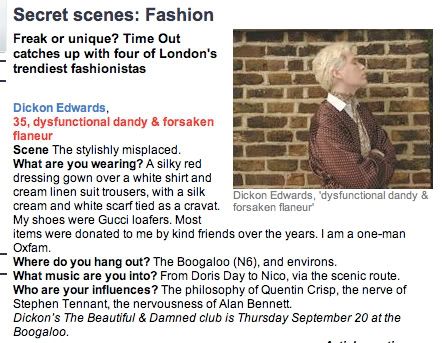
A larger version of the photo is here.
Full article online here.
Strange that they didn’t use a full-length photo, having asked about my shoes and trousers.
One of ‘London’s trendiest fashionistas’? If so, it’s only in the way Peter Sellers’s character in ‘Being There’ is an influential politician.
There was a letter in the magazine the following week:
“Let me get this right. The hottest underground trends in town are… a variety of ponces wearing silly clothes!… Thankfully I am off to see The Fall in Cricklewood, now that’s what I call alternative.”
Never mind me being the anachronistic one: who uses words like ‘ponce’ these days, outside of that scene in ‘Withnail & I?’
Anyway, I don’t think The Fall are exactly strangers to ‘ponces in silly clothes’, given they once collaborated on a ballet with Michael Clark and Leigh Bowery: gentlemen who rather make me look like Chuck Norris.
In the last few months, without lifting a finger to hustle or promote myself, I’ve been featured by The Penny, Inside Out, The Enfield Advertiser, BBC TV and Time Out (several times now).
For better or worse, in some of these instances I feel slightly mistaken for what I’m not. I feel they haven’t quite ‘got’ me. But why should they? There is no reason to feature me at all. As ever, I look more famous than I really am. Until I have something to point to, like a book or an album or a produced script – with decent distribution and marketing behind it, mind- I suppose this is the way it has to be. A club night host, and an online diarist.
But the latter isn’t ‘enough’ by itself, while the former isn’t really my calling. If I took it seriously and put the hours in, I could make The Beautiful & Damned into a proper, paying hit event – even a franchise – given the attention it’s generated as a laid back hobby night on a Thursday night in Zone 3. I could move it to a more central location, book live acts, get in guest DJs, spend money on glossy flyers, even make a career of it. But that isn’t really me, either. I’m better at being a guest than a host. I need something else to point to.
Soon, I hope.

Says Mr R sadly, about a French girl he was chatting to: “I thought we were hitting it off. But I now realise she wasn’t flirting with me. She was just being French.”
Spend two nights in a row DJ-ing at the Boogaloo. The first is a last-minute booking for a private function. It’s something to do with a design company. Or possibly a design magazine. I don’t ask questions, not even when the event involves a transparent holiday caravan being parked on the pavement outside.
Shane MacGowan DJs with me, and his set includes Irish folk numbers such as ‘Barnyards Of Delgaty’ by the Clancy Brothers, played next to ‘Tommy Gun’ by The Clash. Which is pretty much Shane MacGowan in a nutshell. He also spins two versions of a couple of songs, in a sort of compare-and-contrast way. One is ‘Beyond The Sea’ by Bobby Darin, preceded by the original French version, ‘La Mer’ by Charles Trenet. Less known, at least to me, is ‘Stranded In The Jungle’ by The Cadets, a curious novelty hit from the 50s that cuts back and forth from a scene in the said jungle – an encounter with cannibals, naturally – to a swinging doo-wop party in the US. Mr MacG also plays a version of this by The New York Dolls.
The next evening is The Beautiful & Damned, which goes smoothly enough. Films shown: ‘The Eagle’ (Rudolph Valentino) and ‘Sunrise’. When I started the club, we had terrible problems with records being jogged by vibrations of the Charleston-esque dancing, but this no longer happens. The Boogaloo managers have invested in one of those proper CD decks for DJs with a mixing desk built in. Plus my laptop playing mp3s is all non-moving parts, so one can violently shake the table and the music isn’t affected in the slightest.
I put up a few photocopies around the venue, taken from library books on Garbo and other 20s & 30s film stars. One of which, Anita Loos, turns out to be a screenwriter and novelist – best known for ‘Gentlemen Prefer Blondes’. I am mesmerised by her hairdo: the kind of scruffy bob more associated with London 2006 than Hollywood 1932. I’ve said before that all good authors should have hairdos that can be seen from outer space, so I now must read everything she’s written.

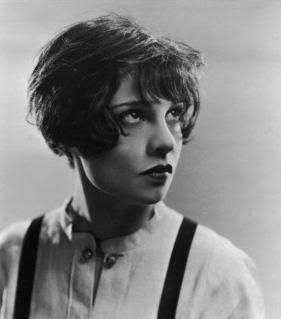
The British Library has dozens of Garbo biographies – not bad for someone who banged on about being left alone.
In a silly mood, and recalling that I prefer the term ‘curator’ to ‘DJ’, I use the following phrase on the club’s poster: ‘Renowned Curators Dickon Edwards & Miss Red Stagger Through The Vaulted Archway Road… to present ‘The Beautiful And Damned’.’
This a reference to the much-derided opening line of The Da Vinci Code. It’s only me who notices, I suspect. But that’s fine with me.
At Beautiful & Damned, Shane MacG insists I play ‘Layla’. After trying hard to say no to him for some time, I finally play the famous squealing rock section, and skip the lesser-known laid-back piano coda. Which makes His Nibs come up and tell me off. So I play that too, a little later. About five people come up and ask me what it is. They all recognise it from the film ‘Goodfellas’: it’s the music playing over a montage of gangsters’ bodies being discovered in different locations. A car, a freezer lorry.
The evening ends with just myself and Mr MacG drinking into the small hours, the pub locked up, the staff gone. I doze off on the sofa next to him, awake at about 4.30, and stagger across the road to bed.
I take home a belated birthday present given to me over the decks by Mr Pushaun, who works in films. It is Anna Massey’s autograph.

Wednesday 20th Sept. Spend the day seeing two new film-festival-type films, Esma’s Secret and Red Road, which have a fair amount in common. At times they even seem like the same film, in the way that action blockbusters can resemble each other. Both have won awards at festivals, and this makes me wonder why arthouse movies are generally considered more edifying than mainstream popcorn fare.
You could argue it’s a question of ticking a a different series of boxes. ‘Little Miss Sunshine’ and ‘Me You And Everyone We Know’ are arthouse movies that seem so aware of their own genre, they are arguably just as formulaic as those Hollywood dramas seemingly created purely to win Oscars. The ones that feature someone with a disability or some other feature that singles them out. All those films have the same plot: A Struggle Against Adversity, Triumphing In The End. But the same is true of the arthouse scene.
The Popcorn Movie must make money. The Arthouse Movie must win film festival awards. The Popcorn Movie must have a certain amount of guns, explosions, or if it’s a romcom, it must finish with a last-dash declaration of love between people who were having a perfectly reasonable life anyway. The Arthouse Movie must try to Say Something about the Human Condition. But not too quickly. And the characters must be generally having a Hard Time throughout. One common feature of arthouse dramas is that information must be withheld, eventually released to the audience as a kind of chocolate-drop reward for sitting still for so long. Once we get The Awful Revelation, we can all go home.
Esma’s Secret was originally called Grbavica, taking its name from its setting: a grim suburb of Sarajevo. Red Road also takes its name from its location: an equally grim suburb of Glasgow. Both are about melancholic women living in the aftermath of some male-instigated trauma, hinted at but unspecified until the final reel. Not so much a Whodunit as a What-was-dun-to-her.
They’re both extremely well acted and directed, and seem terribly real; if it wasn’t for this sense of one box being firmly ticked: the one where you get the audience to stick around for the Awful Revelation. Once the audience feels they’re being strung along for a chocolate drop, as I did, the realism suffers somewhat. And it’s unfair to everything else about the movie. Particularly ‘Red Road’, which has an incredible emotional pull and is otherwise full of original images and ideas.
I was reminded how well ‘Mysterious Skin’ deals with this problem, by following two characters: one is trying to find out the Awful Truth, while the other knows it all too well – and we’ve all been privy to it from the off. To put the shocking secret at the start of the movie rather than the end sidesteps this cliche altogether, while still keeping the audience in suspense, as we get to follow the character in the dark. A building up and an aftermath at the same time.
I suppose wanting to steer away from being accused of boxes-ticking is a kind of box-ticking in itself. Go one step further, and you could say that life can be boiled down to just ticking the right boxes, too. Happiness, tick. Money, tick. Realising your potential, tick. Paying the rent, tick. Perhaps the Afterlife is just filling out a survey form like everything else.
When critics die, do they judge their life out of five stars? Do they look back on their life as an ‘adrenaline-pumping powerhouse’ or a ‘rare treat’ or ‘powerful’?
Dickon Edwards – Nominated for A Lifetime’s Lack Of Achievement Award.

Quick reminder that this month’s Beautiful & Damned night is this THURSDAY.
Recently featured in Time Out magazine’s special on ‘Secret Scenes: The hottest underground trends and subcultures in the capital today.’
THE BEAUTIFUL & DAMNED – SEPTEMBER EDITION
Date: Thursday 21st September
Times: 9pm to 12.30am.
Venue: The Boogaloo, 312 Archway Road, London N6 5AT, UK. 020 8340 2928.
Tube: Highgate (Northern Line). Buses: 43, 134, 263.
Price: Free entry, but do please dress up. Cocktails for the best dressed.
‘Unmissable!’ – Time Out.
‘A divine London night out’ – The Penny Magazine.
With its proud motto of ‘Never Knowingly Underdressed’, The Beautiful And Damned now includes silent movies like ‘Pandora’s Box’ screened on a backdrop to illustrate one’s dancing or conversation. A timezone-jumping decadent disco curated (as opposed to ‘DJ’d’) by Mr Dickon Edwards and Miss Red, the B&D encourages patrons to dress up in their own take on period glamour, ideally with a nod to the styles of the 1920s & 1930s, though anything more stylish than the ubiquitous Old Street fashions is welcome. Cigarillos, braces, tweeds, beads, silk scarves, summer dresses, unforgiving teddy bears, Pimms & high hats.
Drink, dance, and ponder the nights tenderness to an eclectic but discerning mix of Sinatra (Frank & Nancy), Strauss waltzes, soundtracks, musicals, El Records, Peggy Lee, Doris Day, Gilbert & Sullivan, Ella Fitzgerald, Dory Previn, Bugsy Malone, Cabaret, Chicago, deviant disco, shadowy soul, parvenu pop, insouciant indie, and easy listening for difficult children.

Weds 13th – To the BBC to be filmed for a programme about blogging. Though I wince whenever typing that word, preferring to describe my online diary as just that: an online diary. As I’m forever boring people, I started the diary in 1997 just before the word ‘weblog’ was coined, and some time before this was in turn abbreviated to ‘blog’. There’s no changing the fact it’s a thoroughly ugly word. And I don’t usually log what’s going on on the web: I record what’s going on in my life, and in my head. But although I regard this as trying be helpful and accurate, it’s hard not to seem pedantic. This is a programme about blogging, and why everyone is doing it. Even newspaper columnists who were sneering at the Internet ten years ago, calling it a kind of text version of CB radio for geeks and amateurs only, are now seeing their columns converted into blogs. Whether it’ll hang around or not will be interesting to see, but I certainly don’t think the printed word will ever be replaced. There has to come a point where you feel the need to read something that doesn’t depend on batteries or needs servicing. And you’re less likely to be mugged for a book or a newspaper.
For the filming, I’m asked to provide a separate suit and bring my laptop, and am given the choice of taking a BBC cab or going to White City on the tube. Given the extra baggage, I plump for the cab, only to find the driver takes about half an hour trying to work out how to get out of Highgate. We sit in traffic on West Hill for what seems like forever, very near John Betjeman’s old house, in fact. I read too much into the metaphor: stuck in Highgate for what seems like forever, with no apparent hope of ever getting out, then suddenly I’m in a TV studio.
The people in charge are called Satiyesh and Zoe, and are young and cheery. Though her colleagues are in typical casual wear, Ms Z wears a beautiful bottle green full-length dress, even though she’s not on camera. I keep thinking she’s very Verity Lambert. Proper, classic BBC, the way it should be. Frankly, I’m appalled that many BBC studio staff no longer wear ties, but then I would say that. The t-shirted cameraman confesses to me that he only owns two ties. He gives this information unsolicited, and I’m pleased this is the effect I have on some people.
I’m ushered from the Stage Door straight to a room that was once part of the Top Of The Pops set: there’s some half-scratched-away TOTP logos on the pillars. Mr Yentob is nowhere to be seen, though I presume he’s presenting the finished programme, as it’s part of his ‘Imagine’ strand of arts documentaries. I’m just one of the featured bloggers.
I’m asked to read from my diary, and decide on an entry nominated by various readers: the one about looking upon the rest of mankind as your unpaid stunt doubles. Ms Z also likes my recent opening line: “Where to start? Where to stop? Just write it down, that’s all that matters.”
Later, I muse that this is such a good opening line for anything, that I Google it in case I’ve stolen it from somewhere unconsciously. I haven’t, it seems. It’s simple, even impossibly obvious, yet disarmingly inspirational. Telling yourself to write it down IS all that matters. To me and to anyone umming and erring about writing anything at all. Writing calls down more writing.
In addition to the reading, Ms Z interviews me on camera about why I keep the diary. Surrounded in a strange dark room by studio lights and cameras and microphones and all too aware that it’s before 10 a.m., I find it hard to be spontaneously fluent. Thankfully she’s brought notes from a pre-production interview carried out with me a few weeks ago, in the more conducive Maison Bertaux cafe. I was terribly relaxed and full of ideas then, thanks to years of interviewee experience for music publications, webzines, fanzines and so on. What I’m far less experienced at is being interviewed while filmed. So Ms Z kindly reminds me what I said at our earlier, unfilmed meeting, and I do my best to repeat my own answers on camera. Even live television is rehearsed when possible, after all.
This is standard, talking heads TV stuff, like all those ‘100 Best Elbows In Comedy’ and ‘I Love 1981 (But Am Too Young To Remember It) ‘ style programmes. Though at no point does she ask me to sing the theme tune from The Incredible Hulk.
Finally, I am filmed typing away at this laptop… while the chair I’m on revolves. And at some speed. I am a blogger-go-round.
They also film me standing still, holding my laptop, and then not holding it. So mixing these shots together, it will magically appear in my arms. I am then required to write the address of my diary on a wallpaper background in black marker.
These are all rather surreal if not downright odd things to be doing at all, especially on a Wednesday morning without a few drinks first, but I find them far more natural activities than anything non-surreal and non-odd. It’s the normal and the real that I’ve always found unconvincing.
Observation: the BBC has a Costa Coffee shop these days. Like they now have in NHS hospitals.
Fingers crossed my footage is of use to them. Regardless, I enjoyed the happy oddness of it all and the happy company of the directors. Anything for a happily odd life.

Friday September 15th.
I’d never been to to a plaque unveiling ceremony before, so when I heard that Betjeman’s childhood home, 31 West Hill, Highgate, was getting one, I took my camera along. It’s a short walk from my own home, after all.

West Hill is a rather busy, narrow road linking Highgate Village to Kentish Town. There was a fairly decent crowd for the unveiling, spilling out from the house’s front garden onto the thin pavement. Just as well the speakers had a PA system, otherwise they’d have been utterly drowned out by the traffic. A few police were there, which was consoling as a crowd is still a crowd, Betjeman fans or no.

Rather a lot of photographers, too. One of whom was a bit pushy – clearly from a newspaper – and demanded that I help him identify some names he’d been told to snap.
Him: Do you know what A.N. Wilson looks like?
Me: Not entirely.
I now wish I’d said “Yes, that’s me. I am A.N. Wilson”, just to make life more interesting. As it happened, someone took my photo anyway. I wonder what it was for.
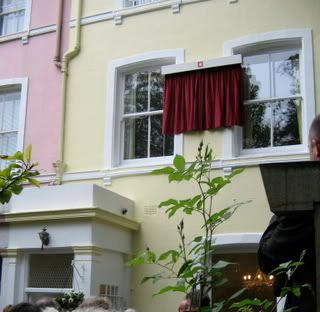
A man from English Heritage, who do the blue plaques, reminded us that they’re suggested by the public, and that the person on the plaque must be dead for at least 20 years. Betjeman died in 1984, so that explains why there hasn’t been a plaque here till now. Mr Motion, the Poet Laureate, told us that Betjeman had once read out one of his own poems when he was a schoolboy. I felt he was going to add “So there.” Then he read the section of Summoned By Bells that contains the line “Deeply I loved thee, 31 West Hill.”
Andrew Motion:
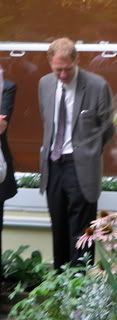
The plaque itself is only a temporary metal version, as we’re told that the proper ceramic one was broken en transit to the English Heritage offices. At some point in the future, a ceramic replacement will go up, without any ceremony. If the man from EH hadn’t brought this up, I’d never have noticed.
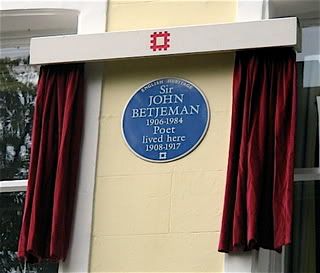
When I mentioned the event to Ms Stone the previous day, she said I should try to get off with someone, if only to later tell people, hand in hand, “We met at a John Betjeman plaque unveiling ceremony.” Well, I didn’t manage that, though I couldn’t resist asking a gentleman called Chris who was walking around with a teddy bear – like Betjeman did – if he would pose with me for a photo.


I am featured in Time Out this week, Page 32 for those of my friends who like to browse in newsagents. I would scan it in to feature here, but I don’t have a scanner. Add that to the Inside Out and Enfield Advertiser features and I’m building up a bit of a clippings backlog for the day I finally procur such a device.
Anyway, it’s as part of a themed issue on London’s New Scenes. The heading for my section is ‘Freak Or Unique’.
Ms S from the magazine, who organised the piece, tells me she’s mortified about this description, saying this was her editor’s heading, not hers, and that she fought against it. She’d wanted ‘London’s Coolest Subcultures’, but he clearly thought ‘Freak Or Unique?’ was better.
I don’t mind; it’s more eye-catching, I suppose. And I’d certainly never call myself cool. Though while I admit myself and the person in the next photo, a Kash Point & Anti-Social regular called Molaroid, appear freakish enough to many, perhaps it’s a bit unfair on the others in the feature, Olly Hodgson and the Stitch And Bitch knitting club ladies. They’re wearing jeans and trainers and look entirely un-freakish. Maybe they’re more ‘unique’ than ‘freak’.
I suspect the editors in question were trying to find a more interesting way of saying ‘London Scenes: Other’, after the preceding features on women’s boxing, performance poetry and so on.
But of course, filing me under simply ‘Other’ is closer to the mark than anything else. I’ve always felt ‘Other’ in most settings.

Am currently reading and writing (I can never quite bring myself to use the W word, ‘working’, which is perhaps part of my problem), in the British Library, St Pancras. Much as I like the more historic Reading Room in the British Museum, this is the place to be for an atmosphere of bookish intensity, for research, for staying till 8pm, and for proper air conditioning. Summer seems to be lingering on into September, at least in London.
Sometimes I lurk in Humanities Two, the room with all the old music papers on the shelves: NME, Melody Maker, Sounds, Record Mirror. And all the old copies of Radio Times – a feast indeed. Melody Maker starts life in the 1920s as little reels of microfiche, then graduates to large binders of the proper issues, before the binders shrink ominously in the late 90s to tabloid format in a desperate attempt to appeal to the youth of the day. A kind of music paper Botox. And of course, then the binders stop shortly after that in 2000, the relaunch having failed to reverse declining sales. Seeing the shelved rows of MM binders suddenly shrink for the last few volumes after so many years is terribly sad. Still, certain unkind hacks at the magazine did actually wish me dead in print at one point.
Here I am, unaccountably alive despite their efforts, staring back at the Melody Maker coffin in a kind of pathetic triumph; and then I realise I’m mocked in turn by the younger pictures of myself within its pages. “Oh, get over it!” shouts back the younger me.
I take a peek on the microfiche collections to discover that New Musical Express starts life on October 4th 1946 as a four-page newspaper called “Accordion Times and Musical Express”. Though on the masthead logo, the words “Accordion Times” are somewhat dwarfed by the much larger “Musical Express” underneath. It’s clear where this publication is going: six years later it’ll be NME proper. The main news stories in late 1946 include rumours of a UK tour by Frank Sinatra.
The accordion-related content is merely a column, revealing that the former “Accordion Times” editor has decided to branch out his remit somewhat with this relaunch in order to improve sales. I’m reminded that current NME writer Peter Robinson also edits the pop-orientated website Popjustice. This includes an audio column by Martin White, featuring his accordion versions of pop songs. I wonder if Mr White and Mr Robinson are aware of the historical precedent for accordion columns in music papers? And will NME be marking the 60th anniversary next month of this initial incarnation?

The BBC have just phoned, confirming what they want from me for this ‘Imagine’ programme about blogging.
I am required to turn up at TV Centre on Wednesday morning and read out a paragraph or so from my diary, on camera. The choice of the excerpt is mine.
Question is, which bit to read?
I’ve just been looking through the archives, and am tempted to read something that dates it to 1998 or 1999, just by way of showing off that I’ve been at this so-called blogging business a lot longer than most people.
For example, “the real tragedy of the Paddington rail crash is Jilly Cooper surviving unscathed.”
I’d quite like to see someone say that on TV. But I suspect someone else has beaten me to it. That’s always the danger with trying to be funny about stories in the news.
But it doesn’t have to be an old entry so much as a readable, entertaining one. Which narrows it down somewhat. So, Dear Reader, if you have a favourite DE diary entry or excerpt that you think would benefit from an airing on BBC1, now is the time to email me at once.
